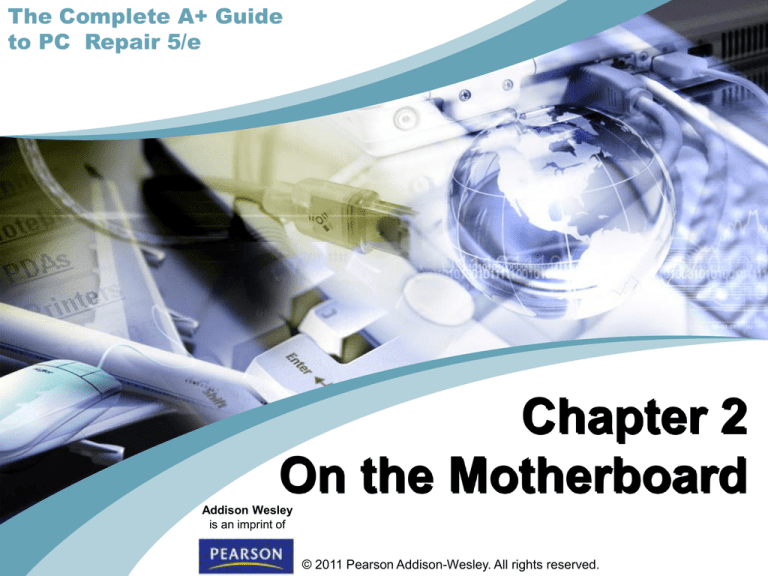
The Complete A+ Guide
to PC Repair 5/e
Chapter 2
On the Motherboard
Addison Wesley
is an imprint of
© 2011 Pearson Addison-Wesley. All rights reserved.
Chapter Objectives
• Define the purpose of the major
components on a motherboard
including the BIOS, clock, front
side bus, and expansion slots.
• Recognize and identify the
motherboard, CPU and
expansion slots.
• Compare and contrast
motherboard expansion
slots.
• Learn the benefits of active
listening.
© 2011 Pearson Addison-Wesley. All rights reserved.
• Explain the basic operation of
a processor and issues to
consider when upgrading it.
• Identify methods to add
functionality to portable
devices.
• Explain different
motherboard technologies
such as HyperTransport,
HyperThreading and multicore.
Processor Overview
1 Microprocessor (or processor)
2 CPU (Central Processing Unit)
3
Clones – IBM compatibles
4
PC (Personal Computer)
Another name for the
microcomputer
© 2011 Pearson Addison-Wesley. All rights reserved.
Byte Table
© 2011 Pearson Addison-Wesley. All rights reserved.
Binary Prefixes
© 2011 Pearson Addison-Wesley. All rights reserved.
Processor Basics
Gigahertz (GHz)
Hertz is a measurement of cycles per second (or frequency). One
hertz equals one cycle per second. One gigahertz (1GHz) is one
billion cycles per second.
Register Size
The number of bits processed at one time by the processor.
Counted in multiples of 8 bits, such as 8-, 16-, and 32-bit register
size. Sometimes referred to as word size by the computer industry.
Processors today have 64-bit or 128-bit register sizes.
Bus
Electronic lines to move the 1s and 0s inside the computer.
© 2011 Pearson Addison-Wesley. All rights reserved.
Processor Basics
Internal
Data Bus
Moves the 1s and 0s inside the
processor.
External
Data Bus
Used to connect the processor to
adapters, storage devices, and
peripherals. Also called the
external data path, these lines
connect to ports and expansion
slots.
© 2011 Pearson Addison-Wesley. All rights reserved.
Processor Basics
Internal and External Data
Buses.
© 2011 Pearson Addison-Wesley. All rights reserved.
Intel Processors
© 2011 Pearson Addison-Wesley. All rights reserved.
AMD Processors
© 2011 Pearson Addison-Wesley. All rights reserved.
Cache
Cache memory
that is located
inside the
processor.
Cache - A fast type of memory
designed to increase the speed of
microprocessor operations.
Cache memory
that is inside the
processor
packaging but
not part of the
CPU, also known
as on-die cache.
© 2011 Pearson Addison-Wesley. All rights reserved.
Cache memory
located in the
CPU housing
or on the
motherboard.
Cache
© 2011 Pearson Addison-Wesley. All rights reserved.
Clocking
Clock Signal
Multiplier
Jumper
• Generated by the
motherboard and
used to control
transfer of 1s and
0s to CPU.
• A number that is
multiplied by the
bus speed to
determine the CPU
speed.
• Small metal
connector with a
plastic cover used
to connect two
metal pins together.
Configuring the
jumpers on a
motherboard will
change the settings
on that board.
© 2011 Pearson Addison-Wesley. All rights reserved.
Clocking
© 2011 Pearson Addison-Wesley. All rights reserved.
Multi-core Processors
Another way to speed up operations is to have two
or more processors.
Dual-core
CPU
Combines two CPUs on a single
unit.
Tri-core
CPU
Combines three processors in a
single unit.
Quad-core
CPU
Two dual-core CPUs installed on the
same motherboard or two dual-core
CPUs installed in a single socket.
© 2011 Pearson Addison-Wesley. All rights reserved.
Multi-core Processors
© 2011 Pearson Addison-Wesley. All rights reserved.
Sockets and Slots
PGA (pin grid
array)
• has even rows of holes around
the square socket
SPGA (staggered
pin array)
• has staggered holes so
more pins can be inserted
PPGA (plastic pin
grid array)
• used on Intel Celerons and
Pentium 4s
µPGA (micro pin
grid array)
• used by AMD
LGA (land grid
array)
© 2011 Pearson Addison-Wesley. All rights reserved.
• used with AMD and Intel
processors
Sockets and Slots
© 2011 Pearson Addison-Wesley. All rights reserved.
Processor Cooling
Many processors now have heat sinks (metal
bars protruding from the CPU to form a basic
radiator) and/or fans. Some systems have
multiple fans.
• Heat Sinks
Liquid is circulated through the system,
including through a heat sink that is mounted
on the CPU. It allows higher clock speeds and is
quieter than a fan.
• Liquid cooling system
© 2011 Pearson Addison-Wesley. All rights reserved.
Heat Sinks
© 2011 Pearson Addison-Wesley. All rights reserved.
Processor Cooling
Correct Air Flow
© 2011 Pearson Addison-Wesley. All rights reserved.
Processor Cooling
Incorrect Air Flow
© 2011 Pearson Addison-Wesley. All rights reserved.
Installing Processors
Computer is off
and
unplugged.
Use antistatic
wrist strap and
attach to a ground
on computer.
Remove old
processor by
lifting ZIF socket
retaining lever.
Insert CPU into
socket (fits
only one way).
Configure motherboard
by jumpers or BIOS
software configuration
(refer to manual for
exact steps).
© 2011 Pearson Addison-Wesley. All rights reserved.
Always hold the CPU
by the edges to avoid
bending or touching
the pins underneath.
Installing Processors
This figure shows
an AMD CPU
being installed.
Notice how the ZIF
socket lever is
raised.
© 2011 Pearson Addison-Wesley. All rights reserved.
Overclocking Processors
Overclocking
Is changing the
front side bus
speed and/or
multiplier to
boost CPU and
system speed.
This can cause
damage to the
CPU,
motherboard,
or other
components.
In order to overclock, you must have the motherboard
documentation to determine whether the system board
supports different CPU speeds and different
multipliers.
© 2011 Pearson Addison-Wesley. All rights reserved.
MMX, SSE and 3DNow!
© 2011 Pearson Addison-Wesley. All rights reserved.
Expansion Slots
Expansion slots
allow adapters to be
installed into the
motherboard to add
capabilities to the
PC.
Be able to identify
expansion slots and
distinguish between
the adapters that
use them.
Be able to install the
proper adapter in the
correct expansion
slot and configure
both correctly.
Know the abilities
and limitations of
each type of
expansion slot when
installing upgrades,
replacing parts or
making
recommendations.
© 2011 Pearson Addison-Wesley. All rights reserved.
ISA (Industry Standard Architecture
• ISA (Industry Standard Architecture) – The oldest
expansion slot, is configured in 8-Bit and 16-Bit slots.
© 2011 Pearson Addison-Wesley. All rights reserved.
PCI (Peripheral Component Interconnect
• PCI (Peripheral
Component Interconnect) –
The previously popular
expansion slot. PCI comes in
four varieties: 32-bit 33MHz,
32-bit 66MHz and 64-bit
33MHz.
• Another standard is the
PCI-X which can operate at
66MHz, 133MHz, 266MHz,
533MHz and 1066MHz.
© 2011 Pearson Addison-Wesley. All rights reserved.
AGP (Accelerated Graphics Port)
AGP – Bus interface for graphics adapters developed
from the PCI bus.
© 2011 Pearson Addison-Wesley. All rights reserved.
AGP (Accelerated Graphics Port)
• Speeds up 3-D graphics,
3-D acceleration and fullmotion playback.
• The video subsystem is
isolated from the rest of the
computer.
• Allows the video adapter to
directly access RAM on the
motherboard when needed.
© 2011 Pearson Addison-Wesley. All rights reserved.
PCIe Overview
© 2011 Pearson Addison-Wesley. All rights reserved.
1
Newer technology
2
Full duplex
3
Serial interface
4
Assigns “lanes” for
use by an
adapter
PCIe
• Different Slot sizes that
represent the maximum
number of lanes assigned to
the slot.
• x1
• x4
• x8
• x16
• A PCIe adapter requires a
minimum number of lanes
• An x4 PCIe adapter works
in a PCIe x4, x8 or x16
expansion slot.
© 2011 Pearson Addison-Wesley. All rights reserved.
PCIe (Peripheral Component InterconnectExpress
© 2011 Pearson Addison-Wesley. All rights reserved.
PCIe
Beware of the
PCIe Fine
Print
Some motherboard
manufacturers offer a
larger slot size, but the slot
runs at a slower speed.
This keeps costs down.
The manual would show
such a slot as x8 (x1
mode) in the PCIe slot
description.
© 2011 Pearson Addison-Wesley. All rights reserved.
Laptop Expansion
Mini PCI
Mini PCIe
ExpressCard
32-bit, 33MHz standard was developed
to allow PCI upgrades and interface
cards to be added to laptops, docking
stations and printers.
Manufacturers are now starting
to use 52-pin mini PCIe cards.
High-performance, hardware
expansion standard for mobile
computers.
© 2011 Pearson Addison-Wesley. All rights reserved.
More Motherboard Connectors
AMR
CNR
ACR
Connector on the
motherboard for
combination
audio and modem
adapters without
taking up a PCI
slot.
Allows integration
of network card
functions with sound
and modem.
Not only supports
audio, modem
and networking,
but also supports
DSL modems.
© 2011 Pearson Addison-Wesley. All rights reserved.
Chipsets
Chipsets are the principle chips on the motherboard that work in
conjunction with the processor and allow specific features.
Chipsets control…
© 2011 Pearson Addison-Wesley. All rights reserved.
Chipsets
© 2011 Pearson Addison-Wesley. All rights reserved.
Types of Motherboards
© 2011 Pearson Addison-Wesley. All rights reserved.
Upgrading and Replacing Motherboards
• There are several issues to
be taken into account when
upgrading a motherboard
• Memory
• Adapter types
• Type of case
• Processor
• Chipsets
• Hard drive
• Power supply
• Future upgrade-ability
© 2011 Pearson Addison-Wesley. All rights reserved.
Motherboard Troubleshooting
© 2011 Pearson Addison-Wesley. All rights reserved.
Soft Skills—Active Listening
Active listening is participating in a conversation where you focus on
what the customer is saying—in other words, listening more than
talking. For a technician, active listening has the following benefits:
• Allows you to gather data and symptoms quickly
• Allows you to build customer rapport
• Improves your understanding of the problem
• Allows you to solve the problem quicker because you understand
the problem better
• Provides mutual understanding between you and your customer
• Provides a means of having a positive, engaged conversation
rather than having a negative,
• confrontational encounter
• Focuses on the customer rather than the technician
• Provides an environment where the customer might be more
forthcoming with information
• related to the problem
© 2011 Pearson Addison-Wesley. All rights reserved.
Questions???
Addison Wesley
is an imprint of
© 2011 Pearson Addison-Wesley. All rights reserved.








